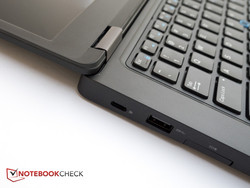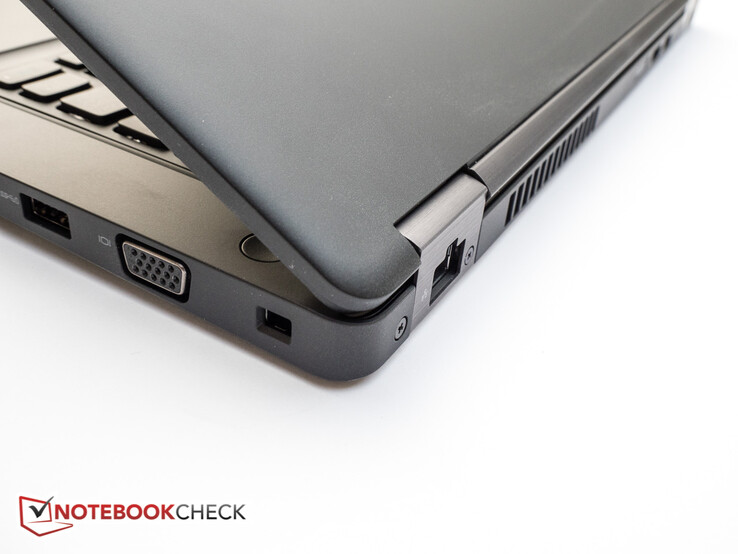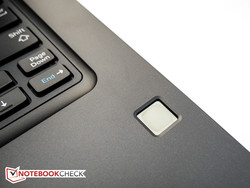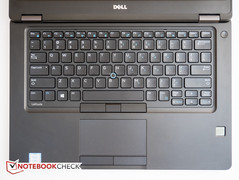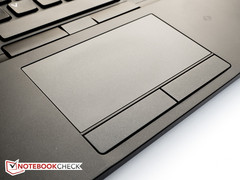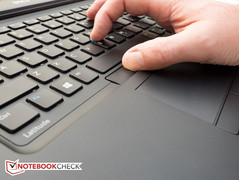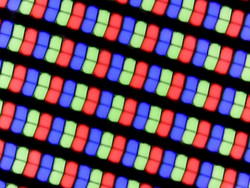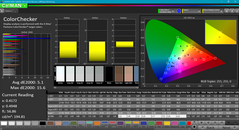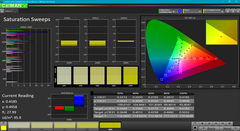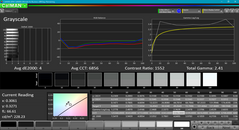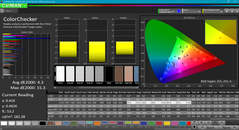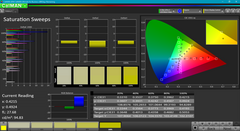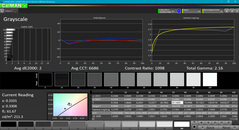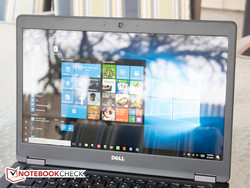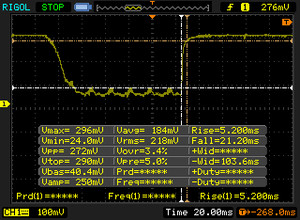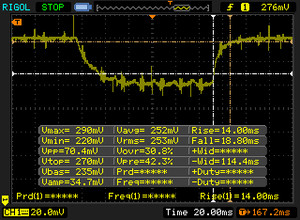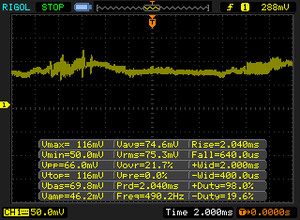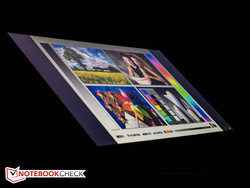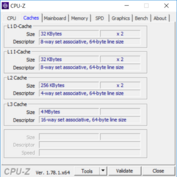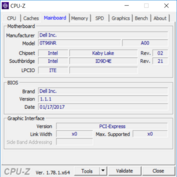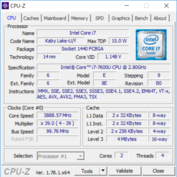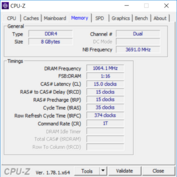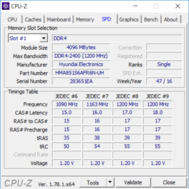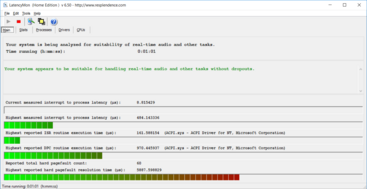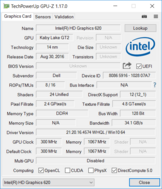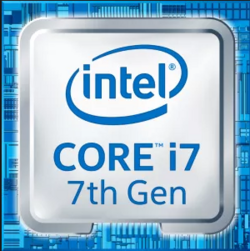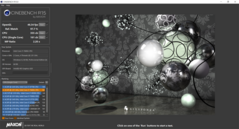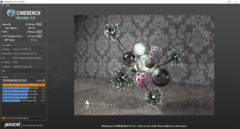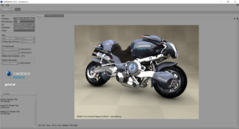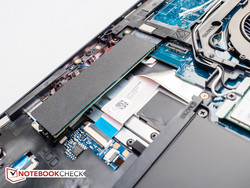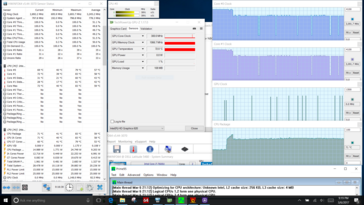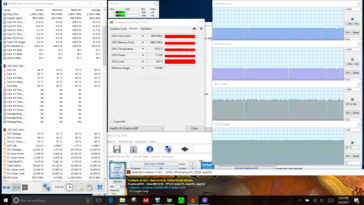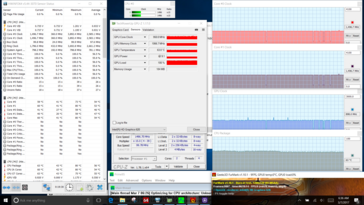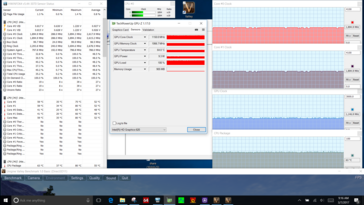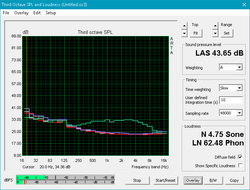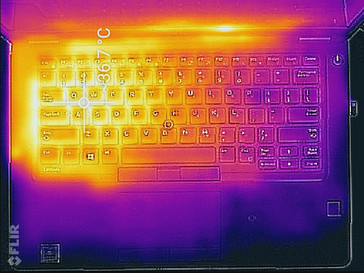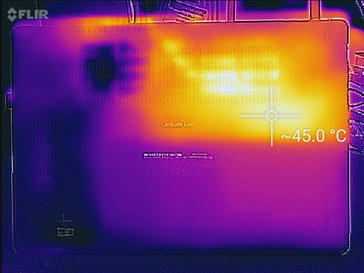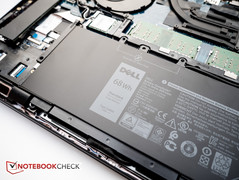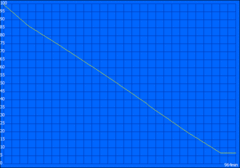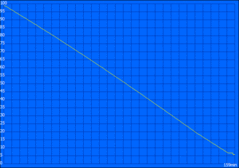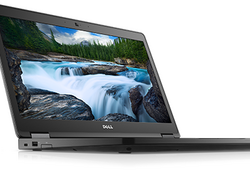Dell Latitude 5480 (7600U, FHD) Laptop Review
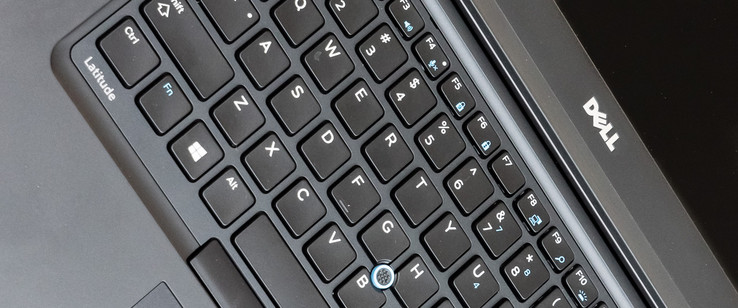
Dell's 14-inch Latitude 5480 business laptop is the successor to the Latitude 14 E5470. As such, the notebook offers a no-frills but durable design, great performance and a compelling array of security features. The "Mainstream" Latitude 5000-series sits between the less expensive "Essential" 3000-line on one side and the "Premium" 7000-series on the other. The starting price of $770 for Dell's mid-range 14-inch Latitude is deceivingly low, but skyrockets rather quickly: the lowest-priced option features a Core i3 CPU, 4 GB RAM, 500 GB 2.5-inch HDD, while our touch-enabled review notebook comes with dual-core i7 CPU, 8 GB of RAM and 256 GB SSD and sells for $1550, so a little more than twice as much. With the most potent hardware selected, the price quickly climbs to above $2000.
As a 14-inch business notebook, our Latitude is of course not without competition. During the review, we'll take a look at how the 5480 compares to the other business-savvy machines like the Lenovo ThinkPad T460s, the new Lenovo ThinkPad T470, the HP ProBook 440 G4, or the the Acer TravelMate P648.
Case
At first glance, the all-black case appears to be the same Dell already used for the predecessor, but closer examination reveals a few differences: while the overall dimensions are virtually identical - the new notebook shaves off a couple mm at best - there are other, more prominent changes like the lack of a dedicated mechanical docking port or the new keyboard tray design. Nonetheless, the overall design philosophy seems to have remained the same: matte surfaces, rounded corners and no real visual accents except for the Dell logo and name and the gunmetal-colored hinges. Speaking of hinges: the fold-flat 180-degree design holds the display lid very well even though our notebook is equipped with a touchscreen and thus a heavier glass layer. A hard rubber/plastic lip surrounds the display and makes contact with the base unit when the lid is closed, so dirt has no chance to get in. The surface materials - which at first appear to be soft-touch like they are on the Dell XPS 13 but aren't - feel decent to the touch and provide ample grip even for moist fingers and hands, but fingerprints show up rather quickly.
The base unit resists twisting pretty well, although our attempts were occasionally accompanied by very slight creaking sounds. The display lid - Dell says they are using carbon fiber reinforced polymer as the material - twists a little more readily, but not enough to compromise durability in any way. The keyboard tray is unfortunately a little too soft in our opinion and pressing down on the G and H keys to the left and right of the "pointstick", as Dell calls the trackpoint, results in quite noticeable flex. Just like the E5470 before it, the new notebook has undergone extensive military-grade MIL-STD 810G testing, however, so it should withstand the rigors of the road quite well.
According to Dell, the Latitude 5480 starts at 1600 g when equipped with the 42 Whr battery, M.2 SSD and non-touch FHD LCD display. Our version with the much larger 68 Whr battery pack and touch display tips the scales at 1776 g / 62.65 oz, making it heavier than comparable notebooks - at times significantly so. The Thinkpad T460s for example, weighs in at only 1345 g / 47.44 oz; only the HP 440 G4 comes quite close at 1702 g / 60.04 oz. The Latitude 5480 is also thicker than the competitors - Dell specifies 22.45 mm / 0.9" at the front - but we don't consider this to be a major disadvantage. The footprint, on the other hand - the 5480 measures about 334 x 229 mm - is quite comparable to the others and matches the footprint of the Thinkpad X1 Carbon almost exactly.
Connectivity
Available physical interfaces are comparatively generous as appropriate for a business notebook. While the Latitude 14 E5470 had the VGA port located on the rear, Dell relocated it to right side on the new notebook. Personally, we would've liked to see the HDMI port there, since many users are likely connecting more modern monitors nowadays. A new addition on the left is what Dell calls a "DisplayPort over USB Type-C" port. During the configuration process, the user can specify Thunderbolt 3-capability, although this change requires the user to select the dedicated NVIDIA GeForce 930MX (+ $90) as well. The Thinkpad T470 natively includes a Thunderbolt 3 port, which also functions as a USB Type-C port (Gen2). As mentioned earlier, the 5480 doesn't come with a docking station port any longer, although Dell does offer various Dock options.
SD Card Reader
The SD card reader manages above-average transfer rates for this type of device. With the Toshiba Exceria Pro SDXC 64 GB UHS-II reference card, our jpeg copy test executed at just over 131 MB/s - a very respectable result trouncing the other laptops in our comparison.
| SD Card Reader | |
| average JPG Copy Test (av. of 3 runs) | |
| Dell Latitude 5480 | |
| Lenovo ThinkPad T470-20HD002HGE | |
| HP ProBook 440 G4-Y8B51EA | |
| Acer TravelMate P648-M-757N | |
| Toshiba Tecra Z40-C-106 | |
| Lenovo ThinkPad T460s-20F9003SGE | |
| maximum AS SSD Seq Read Test (1GB) | |
| Dell Latitude 5480 | |
| Lenovo ThinkPad T470-20HD002HGE | |
| HP ProBook 440 G4-Y8B51EA | |
| Lenovo ThinkPad T460s-20F9003SGE | |
| Toshiba Tecra Z40-C-106 | |
Communication
Our review laptop comes equipped with a Qualcomm QCA6174A 802.11ac 2x2 Wireless Adapter with Bluetooth 4.1. At the time of purchase, the user can also opt for the Intel Dual-Band Wireless-AC 8265 WiFi adapter for $18 more instead; an upgrade to the WiGig-capable Intel Tri-Band Wireless-AC 18265 WiGig adapter costs $28 more. The latter option also requires a change in display configuration - presumably for the antenna - for an additional $21. With a measured receive rate of 645 Mbps, the Latitude 5480 does very well as far as transmission speeds are concerned, although Intel's Dual-Band Wireless-AC 8265 WiFi adapter clearly has the edge when it comes to send rates - both the Lenovo Thinkpad T470 and the HP Spectre x360 are much faster. In the US, the optional mobile broadband option consists of a Qualcomm Snapdragon X7 LTE-A module. When we checked the various online configurations, we were unable to add mobile broadband as an option, so we can't report on the price at this time.
| Networking | |
| iperf3 transmit AX12 | |
| Lenovo ThinkPad T470-20HD002HGE | |
| HP Spectre x360 15-bl002xx | |
| Dell Latitude 5480 | |
| iperf3 receive AX12 | |
| Lenovo ThinkPad T470-20HD002HGE | |
| Dell Latitude 5480 | |
| HP Spectre x360 15-bl002xx | |
Security
Alongside TPM 2.0, the Latitude 5480 features multiple optional security features like multi-factor authentication hardware such as touch fingerprint reader, FIPS 201 Smart Card Reader and or a Contactless Smart Card Reader NFC with Control Vault 2 Fips 140-2 Level 3 Certification to prevent unauthorized access. A Nobel Wedge lock slot allows the user to tether the notebook to deter physical theft. Login in with the fingerprint reader worked reliably and quickly.
Accessories
Dell sells many additional (generic) accessories on their website, ranging from privacy filters, adapter cables and power adapters to various port replicator and docking stations. The Dell Wirless Dock - which requires the aforementioned changes to the configuration at the time of purchase - costs $270 at the time of writing. The cable-based Dell Dock WD15 with 130 W power adapter sells for $200.
Maintenance
Just like the predecessor, the Latitude 5480 lacks any kind of maintenance hatches or flaps. Gaining access to the internal components requires taking of the bottom plate - a fairly easy task after eight screws are removed. Positive: the screws are secured, so they are unlikely to get lost. Once the plate is removed, the user has access to the battery, the HDD (M.2 or 2.5-inch), the WWAN slot, the RAM slots, as well as the cooling fan.
Warranty
While some configurations come with a 3 years hardware service with in-home/onsite service after remote diagnosis, our particular model is only covered for one year. At the time of writing, an upgrade to 3 Years ProSupport with next business day onsite service costs $185; 3 years of ProSupport Plus - Dell's version of accidental damage protection - adds about $255 to the cost of the system.
Please see our Guarantees, Return policies and Warranties FAQ for country-specific information.
Webcam
For business machines, webcams are often a fairly important tool. Our indoor test picture was was taken in a room with a ceiling fan equipped with 3x 13W (60W equivalent) Soft White light bulbs above and to the left of the notebook. Even though the color noise is fairly evident, the white balance is decent and colors are reasonably accurate, so skin tones should be rendered fairly naturally during video conferencing sessions. Pooh's fur lacks details since there isn't that much available light, but we've certainly seen worse.
Input Devices
Keyboard
The chiclet keyboard features 14 mm keys which are slightly concave and pretty smooth to the touch. Key travel is more than adequate at almost 2 mm and bests many current Ultrabooks and consumer notebooks, which generally offer about 1.3 - 1.5 mm worth of travel. The keys are rather softly sprung though and and the feedback isn't what we'd necessarily describe as "crisp". Even so, typing on this keyboard is simply a pleasure - something we didn't quite expect given the fair amount of flex in the middle - and possible at high speeds. The two-stage backlight works well and the keys produce - except maybe for the spacebar - a muffled sound suitable even for very quiet environments.
Touchpad
The Alps touchpad measures 10 x 5.4 cm (4 x 2.1 in). The touch surface is fairly rough to the touch, but that in turn prevents fingers from sticking even when they are slightly moist. Inputs as well as gestures are recognized reliably and translated quickly. The mouse button sit right underneath the touchpad, feature a fair amount of travel and are very quiet, but offer somewhat spongy feedback. Since this isn't a clickpad, this doesn't pose much of a problem during use, however. The pointstick - still our preferred input method when it comes to simply moving the cursor around - works great as well. If we have one issue with the input devices, it's the design of the left and right mouse buttons designated for the pointstick: with the hand on the palmrest and the index finger on the rubber nub, the edge of the material separating the touchpad from the buttons digs into the thumb when clicking. Lenovo uses a more ergonomic design with the touchpad sloping downwards towards the buttons - the mouse buttons essentially appear to be "raised", even though they aren't extending above the keyboard deck.
Touchscreen
The touchscreen responds quickly and accurately even at the edges and in the corners. Dell does not supply a pen or stylus, although any capacitive stylus should work just fine.
Display
Our version of the Latitude 5480 comes equipped with a 14-inch Full-HD IPS touchscreen with a resolution of 1920 x 1080 pixels and a corresponding pixel density of 157 ppi. Dell offers both HD (1366 x 768 pixels) and Full-HD screens in their configuration tool, but only the Full-HD display is available with touchscreen functionality. The panel (LG Philips LGD0553) Dell uses now differs from that of the Latitude 14 E5470 in a few areas, although one sticks out as the most noticeable: the average maximum brightness is significantly lower at 205 cd/m² - the predecessor managed 316 cd/m². Dell specifies 220 nits for the current non-touchscreen as well as the touchscreen Full-HD version. Other notebooks in this category - like the Lenovo ThinkPad T460s or the HP ProBook 440 G4 - aren't very bright either, but many other systems achieve around 250 nits. The Lenovo ThinkPad X1 Carbon and the ThinkPad T470 reach 300 and 290 nits, respectively.
At 980:1, the contrast ratio has much improved compared to the predecessor. The Lenovo notebooks perform about as well as the review candidate; the Acer TravelMate P648 outperforms its peers. The brightness distribution is very uniform and backlight bleeding not an issue.
| |||||||||||||||||||||||||
Brightness Distribution: 90 %
Center on Battery: 215.9 cd/m²
Contrast: 981:1 (Black: 0.22 cd/m²)
ΔE ColorChecker Calman: 5.1 | ∀{0.5-29.43 Ø4.79}
ΔE Greyscale Calman: 4 | ∀{0.09-98 Ø5}
61.15% sRGB (Argyll 1.6.3 3D)
41.96% AdobeRGB 1998 (Argyll 1.6.3 3D)
41.96% AdobeRGB 1998 (Argyll 3D)
61.2% sRGB (Argyll 3D)
40.62% Display P3 (Argyll 3D)
Gamma: 2.41
CCT: 6856 K
| Dell Latitude 5480 LG Philips LGD0553, IPS, 14", 1920x1080 | Dell Latitude 14 E5470 LP140WF3, AH-IPS, WLED, 14", 1920x1080 | Lenovo ThinkPad T460s-20F9003SGE N140HCE-EAA, LEN40A9, IPS, 14", 1920x1080 | HP ProBook 440 G4-Y8B51EA AUO1E3D, TN, 14", 1920x1080 | Lenovo ThinkPad X1 Carbon 20FB-005XUS IPS, 14", 1920x1080 | Acer TravelMate P648-M-757N AU Optronics B140HAN02.1, IPS, 14", 1920x1080 | Lenovo ThinkPad T470-20HD002HGE N140HCA-EAB, IPS, 14", 1920x1080 | Toshiba Tecra Z40-C-106 Toshiba TOS508F, IPS, 14", 1920x1080 | |
|---|---|---|---|---|---|---|---|---|
| Display | 49% | 2% | -7% | 42% | -13% | 2% | 48% | |
| Display P3 Coverage (%) | 40.62 | 64.8 60% | 41.65 3% | 37.6 -7% | 58.9 45% | 35.53 -13% | 41.6 2% | 64.8 60% |
| sRGB Coverage (%) | 61.2 | 84.8 39% | 61.6 1% | 56.6 -8% | 83.1 36% | 53.3 -13% | 61.9 1% | 84.4 38% |
| AdobeRGB 1998 Coverage (%) | 41.96 | 62 48% | 43.14 3% | 38.85 -7% | 60.3 44% | 36.72 -12% | 43.06 3% | 61.7 47% |
| Response Times | -9% | -20% | -12% | -25% | -15% | -28% | 3% | |
| Response Time Grey 50% / Grey 80% * (ms) | 32.8 ? | 39 ? -19% | 42 ? -28% | 43.2 ? -32% | 47.2 ? -44% | 44 ? -34% | 41.6 ? -27% | 32.8 ? -0% |
| Response Time Black / White * (ms) | 26.4 ? | 26 ? 2% | 29.2 ? -11% | 24.4 ? 8% | 27.6 ? -5% | 25 ? 5% | 34 ? -29% | 25.2 ? 5% |
| PWM Frequency (Hz) | ||||||||
| Screen | 6% | -8% | -40% | 24% | 13% | -1% | 5% | |
| Brightness middle (cd/m²) | 215.9 | 323 50% | 226 5% | 216 0% | 321.7 49% | 254 18% | 306 42% | 269 25% |
| Brightness (cd/m²) | 205 | 316 54% | 211 3% | 203 -1% | 301 47% | 243 19% | 287 40% | 257 25% |
| Brightness Distribution (%) | 90 | 79 -12% | 89 -1% | 83 -8% | 89 -1% | 90 0% | 88 -2% | 86 -4% |
| Black Level * (cd/m²) | 0.22 | 0.57 -159% | 0.22 -0% | 0.47 -114% | 0.294 -34% | 0.19 14% | 0.3 -36% | 0.52 -136% |
| Contrast (:1) | 981 | 567 -42% | 1027 5% | 460 -53% | 1094 12% | 1337 36% | 1020 4% | 517 -47% |
| Colorchecker dE 2000 * | 5.1 | 3.68 28% | 6.44 -26% | 8.98 -76% | 3.96 22% | 4.93 3% | 6.2 -22% | 3.45 32% |
| Colorchecker dE 2000 max. * | 15.6 | 8.33 47% | 17.18 -10% | 14.07 10% | 6.69 57% | 10.14 35% | 13.6 13% | 9.34 40% |
| Greyscale dE 2000 * | 4 | 2.99 25% | 5.87 -47% | 9.61 -140% | 3.15 21% | 2.71 32% | 5.8 -45% | 2.28 43% |
| Gamma | 2.41 91% | 2.49 88% | 2.37 93% | 2.63 84% | 2.34 94% | 2.36 93% | 2.04 108% | 2.38 92% |
| CCT | 6856 95% | 6572 99% | 6856 95% | 11265 58% | 7082 92% | 6914 94% | 6277 104% | 6230 104% |
| Color Space (Percent of AdobeRGB 1998) (%) | 41.96 | 55 31% | 39.58 -6% | 35.9 -14% | 53.8 28% | 34 -19% | 39.62 -6% | 55.24 32% |
| Color Space (Percent of sRGB) (%) | 61.15 | 85 39% | 61.15 0% | 56.7 -7% | 82.7 35% | 53 -13% | 61.44 0% | 84.32 38% |
| Total Average (Program / Settings) | 15% /
13% | -9% /
-7% | -20% /
-30% | 14% /
21% | -5% /
4% | -9% /
-4% | 19% /
13% |
* ... smaller is better
At 61 % and 42 % for the sRGB and AdobeRGB standards, color space coverage is far from stellar, but certainly not a dealbreaker for a business notebook. The Lenovo ThinkPad X1 Carbon covers about 83 % of sRGB and would thus be a better choice for users who want to use their machine for photo editing. The predecessor Latitude 14 E5470 also had much better color space coverage.
To determine how accurate the panel is in terms of color reproduction, we use a colorimeter and the CalMan software. The average DeltaE values of 4 and 5.1 for grayscale and color, respectively, are pretty decent (the goal are deviations of less than 3), but blue in particular deviates much more from the ideal value than the other colors. A quick calibration had next to no effect in correcting the color blue, but the color balance did improve. Overall, colors do appear quite natural and the accuracy is certainly on par for a business laptop.
Outdoor usability is comparatively poor: the low brightness in combination with the highly reflective panel makes usage even in moderately-bright environments a challenge at times. Even working in the shade requires a panel adjustment to minimize reflections. The predecessor Dell Latitude 14 E5470 as well as the Thinkpad X1 Carbon and ThinkPad T470 with their matte panels and higher brightness are much better suited to outdoor use.
Display Response Times
| ↔ Response Time Black to White | ||
|---|---|---|
| 26.4 ms ... rise ↗ and fall ↘ combined | ↗ 5.2 ms rise | |
| ↘ 21.2 ms fall | ||
| The screen shows relatively slow response rates in our tests and may be too slow for gamers. In comparison, all tested devices range from 0.1 (minimum) to 240 (maximum) ms. » 65 % of all devices are better. This means that the measured response time is worse than the average of all tested devices (20.3 ms). | ||
| ↔ Response Time 50% Grey to 80% Grey | ||
| 32.8 ms ... rise ↗ and fall ↘ combined | ↗ 14 ms rise | |
| ↘ 18.8 ms fall | ||
| The screen shows slow response rates in our tests and will be unsatisfactory for gamers. In comparison, all tested devices range from 0.165 (minimum) to 636 (maximum) ms. » 43 % of all devices are better. This means that the measured response time is similar to the average of all tested devices (31.7 ms). | ||
Screen Flickering / PWM (Pulse-Width Modulation)
| Screen flickering / PWM not detected | |||
In comparison: 53 % of all tested devices do not use PWM to dim the display. If PWM was detected, an average of 8152 (minimum: 5 - maximum: 343500) Hz was measured. | |||
Viewing angles are excellent with no apparent changes in colors, although the brightness seems to decrease at a slightly higher rate when deviating from the vertical than what we've experienced with other panels. For everyday use, this minor dip in brightness is of no consequence, however. Thanks to the IPS technology, the Latitude 5480 far outperforms laptops outfitted with regular TN panels like the HP ProBook 440 G4.
Performance
At the time of our review, the Latitude 5480 is available with i3, i5, and i7 Kaby Lake processors, ranging from the ULV Core i3-7100U (dual-core, 2.4 GHz, 3M Cache, 15W TDP) to the Core i7-7820HQ (quad-core, 2.9GHz up to 3.9GHz, 8M Cache, 35W TDP). Our particular laptops is equipped with Intel Core i7-7600U (dual-core, 2.8GHz up to 3.9 GHz, 4M Cache, 15W). Most configurations on Dell's website can be configured with up to 16GB of DDR4 Memory in a 2x 8GB configuration and SSD drives up to 512 GB. The high-end models can also be configured with a dedicated Nvidia GeForce 930MX GPU for $90 more; our Latitude makes use of the integrated Intel HD Graphics 620.
When equipped with the i7-7820HQ CPU, 16 GB of RAM and a 512 GB PCIe NVMe SSD, the Latitude 5480 can cost up to a staggering $2300 - certainly far from inexpensive for a mid-range model.
Subjective system performance is great thanks to the speedy CPU and the Solid Disk Drive. We never experienced any crashes or performance issues during our time with the laptop.
Processor
The Intel Core i7-7600U is a high-end Kaby Lake dual-core ULV processor clocked at a base speed of 2.8 GHz with Turbo Boost up to 3.9 GHz. Given its specs, it should outperform the much more common Intel Core i7-7500U (2.7 - 3.5 GHz) the HP ProBook 440 G4 is equipped with by less than 10 %. A quick look at Cinebench R15 confirms this assumption, as the Latitude 5480 scored 161 points for single-core and 355 points for the dual-core portion, whereas the ProBook scored 145 and 335 points, respectively.
Users upgrading to the top-of-the-line Core i7-7820HQ can likely expect multi-core speed increases of 40 % or more, but since this is a 35 W CPU, the battery life will be significantly lower as well. The entry-level model with Core i3-7100U CPU will likely be between 30 - 45 % slower than i7-7500U in the review notebook.
As seen in the graph below, the CPU of the Latitude 5480 delivers fairly consistent performance with only a few outliers even with the Cinebench 15 multi-core test running in a loop for about 30 minutes. Some laptops - especially passively-cooled ones - will show a marked decline in performance when under load for an extended period of time.
| Cinebench R10 | |
| Rendering Single 32Bit | |
| Dell Latitude 5480 | |
| HP ProBook 440 G4-Y8B51EA | |
| Dell Latitude 14 E5470 | |
| Lenovo ThinkPad X1 Carbon 20FB-005XUS | |
| Acer TravelMate P648-M-757N | |
| Rendering Multiple CPUs 32Bit | |
| Dell Latitude 14 E5470 | |
| Dell Latitude 5480 | |
| HP ProBook 440 G4-Y8B51EA | |
| Acer TravelMate P648-M-757N | |
| Lenovo ThinkPad X1 Carbon 20FB-005XUS | |
| wPrime 2.10 - 1024m | |
| Lenovo ThinkPad X1 Carbon 20FB-005XUS | |
| Dell Latitude 5480 | |
* ... smaller is better
System Performance
A high-performance dual-core i7 processor, 8 GB of DDR4 RAM running in dual-channel mode and a fast SSD - the Latitude is no slouch when it comes to performance. According to PCMark 8, the HP ProBook 440 G4 with Core i7-7500U and dedicated GeForce 930MX doesn't have an advantage here and is actually slower by 3 - 8 % depending on the subtest. Notebooks with older previous-generation CPUs like the Acer TravelMate P648 with Core i7-6500U are 8 - 23 % slower.
When running 3DMark 11, the Latitude 5480 performs the same no if it is plugged in or running on battery power.
| PCMark 8 Home Score Accelerated v2 | 3913 points | |
| PCMark 8 Creative Score Accelerated v2 | 4923 points | |
| PCMark 8 Work Score Accelerated v2 | 4992 points | |
Help | ||
Storage Devices
The Latitude 5480 can either be equipped with 2.5-inch conventional HDDs or M.2 / PCIe NVMe SSDs - but not both. An upgrade from the base 500 GB 7200 RPM platter-based drive to a M.2 2280 SATA SSD with 256 GB - the drive our review notebook is equipped with - costs $140. The most expensive drive is a 512 GB PCIe NVME 2280 SSD, which adds almost $400 to the price of the notebook.
The performance of the 256 GB Toshiba SSD THNSN5512GPUK is very good, but far from spectacular with read and write rates of 470 and 265 MB/s according to CrystalDiskMark. Most notebooks in our comparison - except for the Lenovo ThinkPad T460s - post both higher sequential read as well as write rates. Based on our real-world experience and the fact that speed differences are hardly going to be noticeable, we'd rather upgrade the RAM to 16 GB instead of switching to a PCIe NVMe drive. For our review laptop, and upgrade to a 256 GB PCIe NVMe drive would've added about $90; a RAM upgrade to 2x 8 GB of DDR4 RAM was $125 at the time of writing.
| Dell Latitude 5480 Toshiba SG5 256GB THNSNK256GVN8 | Dell Latitude 14 E5470 Micron SSD 1100 (MTFDDAV256TBN) | Lenovo ThinkPad T460s-20F9003SGE Samsung CM871 MZ7LF192HCGS | HP ProBook 440 G4-Y8B51EA SanDisk SD8SNAT256G1002 | Lenovo ThinkPad X1 Carbon 20FB-005XUS Samsung SM951 MZVPV256 m.2 | Acer TravelMate P648-M-757N Lite-On CV1-8B256 | Toshiba Tecra Z40-C-106 Toshiba HG6 THNSNJ256G8NY | |
|---|---|---|---|---|---|---|---|
| CrystalDiskMark 3.0 | -7% | -52% | -11% | 177% | 6% | 3% | |
| Read Seq (MB/s) | 469.4 | 465.4 -1% | 446.5 -5% | 491.2 5% | 1720 266% | 531 13% | 521 11% |
| Write Seq (MB/s) | 264.8 | 363.1 37% | 171.1 -35% | 322.2 22% | 1263 377% | 358.8 35% | 444.5 68% |
| Read 512 (MB/s) | 408.1 | 338.4 -17% | 259.2 -36% | 310.1 -24% | 1223 200% | 384.8 -6% | 420.2 3% |
| Write 512 (MB/s) | 265.5 | 246.1 -7% | 167.2 -37% | 276 4% | 1249 370% | 363 37% | 421 59% |
| Read 4k (MB/s) | 24.66 | 25.83 5% | 5.78 -77% | 19.57 -21% | 49.65 101% | 31.3 27% | 20.32 -18% |
| Write 4k (MB/s) | 114.8 | 80.3 -30% | 35.47 -69% | 77.8 -32% | 123 7% | 80.3 -30% | 79.6 -31% |
| Read 4k QD32 (MB/s) | 380.3 | 246.1 -35% | 94.9 -75% | 146.3 -62% | 464.6 22% | 239.4 -37% | 229 -40% |
| Write 4k QD32 (MB/s) | 207.2 | 197.7 -5% | 36.43 -82% | 241.4 17% | 354.7 71% | 225.3 9% | 153.6 -26% |
GPU Performance
The Intel HD Graphics 620 is an ULV processor-integrated Kaby Lake GPU with 24 unified shaders. In case of the Core i7-7600U, the maximum clock speed is 1150 MHz. Systems like the 12.5-inch HP EliteBook 820 G4 with i7-7500U processor and the Intel HD Graphics 620, which in case of the 7500U processor is limited to a maximum of 1050 Mhz, are about 10 % slower according to 3DMark 11. It also helps that the review notebook is equipped with two high-speed RAM modules running in dual-channel mode, which improves the graphics performance. An upgrade to the Maxwell-based Nvidia GeForce 930MX will likely result in performance increases of about 30 % depending on the task at hand.
| 3DMark 11 Performance | 1845 points | |
| 3DMark Ice Storm Standard Score | 67522 points | |
| 3DMark Cloud Gate Standard Score | 6916 points | |
| 3DMark Fire Strike Score | 952 points | |
| 3DMark Fire Strike Extreme Score | 444 points | |
Help | ||
Gaming Performance
Since this is a business notebook, gaming performance plays a secondary role at best. While older games like Anno 2070 or Tomb Raider work reasonably well, newer games are not going to be playable at adequate frame rates even at low resolutions and at the lowest quality settings.
| Tomb Raider | |
| 1024x768 Low Preset (sort by value) | |
| Dell Latitude 5480 | |
| Lenovo ThinkPad T460s-20F9003SGE | |
| HP ProBook 440 G4-Y8B51EA | |
| Acer TravelMate P648-M-757N | |
| 1366x768 Normal Preset AA:FX AF:4x (sort by value) | |
| Dell Latitude 5480 | |
| Lenovo ThinkPad T460s-20F9003SGE | |
| HP ProBook 440 G4-Y8B51EA | |
| Acer TravelMate P648-M-757N | |
| 1366x768 High Preset AA:FX AF:8x (sort by value) | |
| Dell Latitude 5480 | |
| Lenovo ThinkPad T460s-20F9003SGE | |
| HP ProBook 440 G4-Y8B51EA | |
| Acer TravelMate P648-M-757N | |
| 1920x1080 Ultra Preset AA:FX AF:16x (sort by value) | |
| Dell Latitude 5480 | |
| HP ProBook 440 G4-Y8B51EA | |
| Acer TravelMate P648-M-757N | |
| low | med. | high | ultra | |
|---|---|---|---|---|
| Anno 2070 (2011) | 88.9 | 49.7 | 30.3 | 13.8 |
| Tomb Raider (2013) | 86.2 | 45.1 | 28.6 | 13.2 |
Stress Test
We stress both the CPU and GPU to check for throttling and stability issues. With Prime95 running on its own, the cores slowed down from the initial 3.9 GHz to about 3.1 - 3.2 GHz at a temperature of about 72 C. Occasionally we observed dips down to 743 MHz, but the recovery was always immediate. Even after a prolonged runtime, we saw no significant changes. Furmark on its own resulted in GPU speeds of 950 - 1150 MHz at a temperature of 68 degrees. After 15 minutes, the GPU only reached a maximum of 900 - 950 MHz, although the temperature had not changed significantly. Simultaneous CPU and GPU stress resulted in CPU throttling down to 1.5 GHz with the GPU hovering between 900 - 950 MHz. Just like the CPU, the GPU would occasionally dip down for a split second or so - to 340 MHz in this case. We observed no other changes during the remainder of the test. A subsequent run of PCMark 11 with the Latitude still hot from the stress test showed no apparent decrease in performance.
Unigine Heaven simulates real-world loads like gaming and other demanding tasks. The CPU and the GPU maintained between 2.9 - 3.4 GHz and 1100 - 1150 MHz, respectively at a temperature of about 64 degrees C. About ten minutes later, the CPU only reached about 2.9 GHz with the GPU running at 850 - 900 MHz. The temperature had decreased to about 62 C.
Noteworthy is the fact that the system fan would continue running for several minutes after the load was removed - many other notebooks show a near-immediate decrease in fan RPMs.
| CPU Clock (GHz) | GPU Clock (MHz) | Average CPU Temperature (°C) | Average GPU Temperature (°C) | |
| Prime95 Stress | 3.2 | - | 72 | |
| FurMark Stress | - | 950 | - | 68 |
| Prime95 + FurMark Stress | 1.5 | 950 | 63 | 63 |
| Unigine Heaven Stress | 3.2 | 1100 | 64 | 64 |
Emissions
System Noise
As we've seen during the stress test, the single system fan handles the ULV Intel processor quite easily with temperatures rarely exceeding 70 C. During idle, the noise level remains at under 30 dB at all times. Low to medium loads cause the fan to spool up and the noise increases from 33 to 42 dB. The maximum observed noise floor was 47 dB, although this requires unrealistic loads unlikely to occur during normal use. Even at maximum load levels, the Latitude 5480 never sounds overly obtrusive. All other laptops in our comparison are not nearly as loud, however, with only the HP ProBook 440 approaching 40 dB. The Acer TravelMate P648 is whisper-quiet by comparison at just over 32 dB.
We noticed an intermittent high-pitched whining sound ("coil whine") during SSD access - particularly when running disk benchmarks. While this likely has no detrimental effect, it is audible from a distance of about 3 feet, which might be bothersome for some users.
Noise level
| Idle |
| 29.6 / 29.6 / 29.6 dB(A) |
| Load |
| 42 / 47.1 dB(A) |
 | ||
30 dB silent 40 dB(A) audible 50 dB(A) loud |
||
min: | ||
| Dell Latitude 5480 HD Graphics 620, i7-7600U, Toshiba SG5 256GB THNSNK256GVN8 | Acer TravelMate P648-M-757N HD Graphics 520, 6500U, Lite-On CV1-8B256 | Lenovo ThinkPad T460s-20F9003SGE HD Graphics 520, 6200U, Samsung CM871 MZ7LF192HCGS | HP ProBook 440 G4-Y8B51EA GeForce 930MX, i7-7500U, SanDisk SD8SNAT256G1002 | Lenovo ThinkPad X1 Carbon 20FB-005XUS HD Graphics 520, 6300U, Samsung SM951 MZVPV256 m.2 | Toshiba Tecra Z40-C-106 HD Graphics 520, 6200U, Toshiba HG6 THNSNJ256G8NY | Dell Latitude 14 E5470 HD Graphics 530, 6440HQ, Micron SSD 1100 (MTFDDAV256TBN) | |
|---|---|---|---|---|---|---|---|
| Noise | 7% | 10% | 7% | 10% | 8% | 9% | |
| Idle Minimum * (dB) | 29.6 | 31.2 -5% | 29.1 2% | 29 2% | 28.8 3% | 29.8 -1% | 30.3 -2% |
| Idle Average * (dB) | 29.6 | 31.2 -5% | 29.1 2% | 29 2% | 28.9 2% | 29.8 -1% | 30.3 -2% |
| Idle Maximum * (dB) | 29.6 | 31.6 -7% | 29.1 2% | 29 2% | 28.9 2% | 29.8 -1% | 30.3 -2% |
| Load Average * (dB) | 42 | 33.3 21% | 32.3 23% | 37.4 11% | 35 17% | 32.6 22% | 31.6 25% |
| Load Maximum * (dB) | 47.1 | 32.4 31% | 36.6 22% | 39 17% | 35.8 24% | 37.2 21% | 35 26% |
| off / environment * (dB) | 31.2 | 29.1 | 29 | 28.8 | 29 | 30.3 |
* ... smaller is better
Temperature
Idle temps are quite low with no area of the notebook exceeding 27 C at an ambient temperature of 20 C. Extremely high loads (stress test) causes the temperature to rise to 45 degrees on the bottom left side and can make lap use slightly uncomfortable.The palm rests remain always cool to the touch and never exceed 25 degrees. The Latitude does get quite hot, especially considering that it is thicker than the other business notebooks in our comparison: the super-thin (16.5 mm) ThinkPad X1 Carbon only reaches a maximum of 43 C. The Latitude's overall heat signature doesn't bode well for the top-of-the-line version with 35 W CPU and dedicated graphics card, which is likely going to run much hotter. The predecessor with Core i5-6440HQ and integrated GPU only reached 43 C - but it appears that Dell has redesigned the cooling system, as the fan is in a different position with the fan exhaust venting to rear instead of the left side.
(+) The maximum temperature on the upper side is 36.4 °C / 98 F, compared to the average of 34.3 °C / 94 F, ranging from 21.2 to 62.5 °C for the class Office.
(±) The bottom heats up to a maximum of 45 °C / 113 F, compared to the average of 36.8 °C / 98 F
(+) In idle usage, the average temperature for the upper side is 24 °C / 75 F, compared to the device average of 29.5 °C / 85 F.
(+) The palmrests and touchpad are cooler than skin temperature with a maximum of 24.8 °C / 76.6 F and are therefore cool to the touch.
(+) The average temperature of the palmrest area of similar devices was 27.6 °C / 81.7 F (+2.8 °C / 5.1 F).
Speakers
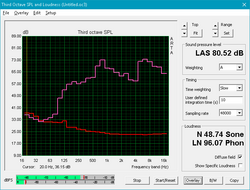
The stereo speakers are located on the front edge and fire downwards as well as forward. As it is typical for small business notebooks, the sound quality isn't exactly a revelation. Although the bass is lacking - but still present - the mids are surprisingly well balanced. The speakers get quite loud without distorting and voices are very clear and easy to understand - certainly a bonus for a business notebook which might see video conferencing duties. As always, we recommend external speakers or headphones for better sound quality.
Dell Latitude 5480 audio analysis
(±) | speaker loudness is average but good (80.5 dB)
Bass 100 - 315 Hz
(±) | reduced bass - on average 8.7% lower than median
(±) | linearity of bass is average (10.1% delta to prev. frequency)
Mids 400 - 2000 Hz
(+) | balanced mids - only 3.6% away from median
(±) | linearity of mids is average (7.8% delta to prev. frequency)
Highs 2 - 16 kHz
(±) | higher highs - on average 5.7% higher than median
(±) | linearity of highs is average (9.2% delta to prev. frequency)
Overall 100 - 16.000 Hz
(±) | linearity of overall sound is average (15.6% difference to median)
Compared to same class
» 15% of all tested devices in this class were better, 4% similar, 81% worse
» The best had a delta of 7%, average was 21%, worst was 53%
Compared to all devices tested
» 23% of all tested devices were better, 4% similar, 73% worse
» The best had a delta of 4%, average was 24%, worst was 134%
Apple MacBook 12 (Early 2016) 1.1 GHz audio analysis
(+) | speakers can play relatively loud (83.6 dB)
Bass 100 - 315 Hz
(±) | reduced bass - on average 11.3% lower than median
(±) | linearity of bass is average (14.2% delta to prev. frequency)
Mids 400 - 2000 Hz
(+) | balanced mids - only 2.4% away from median
(+) | mids are linear (5.5% delta to prev. frequency)
Highs 2 - 16 kHz
(+) | balanced highs - only 2% away from median
(+) | highs are linear (4.5% delta to prev. frequency)
Overall 100 - 16.000 Hz
(+) | overall sound is linear (10.2% difference to median)
Compared to same class
» 7% of all tested devices in this class were better, 2% similar, 91% worse
» The best had a delta of 5%, average was 18%, worst was 53%
Compared to all devices tested
» 4% of all tested devices were better, 1% similar, 94% worse
» The best had a delta of 4%, average was 24%, worst was 134%
Frequency Comparison (Checkbox selectable!)
Graph 1: Pink Noise 100% Vol.; Graph 2: Audio off
Energy Management
Power Consumption
Maximum power consumption during idle is about 7.8 W and thus in the same ballpark as the Tecra Z40-C-106 or the Lenovo ThinkPad T460s. Heavy loads cause the Latitude to draw about 32 W, which is quite modest when compared to the HP ProBook 440 G4, which draws over 60 watts. Our 65 W power adapter is more than sufficient and never gets hotter than 36 C, but Dell also offers a 90 W model - presumably for the more power-hungry top-of-the-line Latitudes.
| Off / Standby | |
| Idle | |
| Load |
|
Key:
min: | |
| Dell Latitude 5480 i7-7600U, HD Graphics 620, Toshiba SG5 256GB THNSNK256GVN8, IPS, 1920x1080, 14" | Acer TravelMate P648-M-757N 6500U, HD Graphics 520, Lite-On CV1-8B256, IPS, 1920x1080, 14" | Lenovo ThinkPad T460s-20F9003SGE 6200U, HD Graphics 520, Samsung CM871 MZ7LF192HCGS, IPS, 1920x1080, 14" | HP ProBook 440 G4-Y8B51EA i7-7500U, GeForce 930MX, SanDisk SD8SNAT256G1002, TN, 1920x1080, 14" | Lenovo ThinkPad X1 Carbon 20FB-005XUS 6300U, HD Graphics 520, Samsung SM951 MZVPV256 m.2, IPS, 1920x1080, 14" | Toshiba Tecra Z40-C-106 6200U, HD Graphics 520, Toshiba HG6 THNSNJ256G8NY, IPS, 1920x1080, 14" | Dell Latitude 14 E5470 6440HQ, HD Graphics 530, Micron SSD 1100 (MTFDDAV256TBN), AH-IPS, WLED, 1920x1080, 14" | |
|---|---|---|---|---|---|---|---|
| Power Consumption | -14% | 11% | -4% | -9% | 5% | -19% | |
| Idle Minimum * (Watt) | 6.64 | 5.3 20% | 3.7 44% | 3 55% | 7.6 -14% | 4.3 35% | 4.1 38% |
| Idle Average * (Watt) | 6.67 | 9.3 -39% | 6.8 -2% | 5.4 19% | 9 -35% | 7.6 -14% | 8.1 -21% |
| Idle Maximum * (Watt) | 7.78 | 11.5 -48% | 7.3 6% | 6.3 19% | 9.6 -23% | 8.3 -7% | 11.4 -47% |
| Load Average * (Watt) | 30.83 | 30.8 -0% | 26.3 15% | 37.5 -22% | 24.5 21% | 26.8 13% | 33.5 -9% |
| Load Maximum * (Watt) | 31.7 | 32 -1% | 34.6 -9% | 61.1 -93% | 30.3 4% | 32.6 -3% | 49 -55% |
* ... smaller is better
Battery Life
Equipped with a high-capacity 68 Wh battery, the Latitude 5480 is capable of stellar run times. During our WLAN test, the notebook ran for 16 hours before we had to plug it back in. The review notebook is simply without peers here with the Acer TravelMate P648 (54 Wh) in second place with a recorded run time of 9 hours. When equipped with the 72 Wh secondary battery, the ThinkPad T470 could potentially potentially last ~14.5 hours according to our estimates - but this larger pack doesn't sit flush with the chassis and increases not only the weight, but also the size. The Readers test - which we use to establish the maximum run times - took a ridiculously long 24 hours to complete. It goes without saying that the laptop will easily last an entire workday and then some.
We should mention here that according to the spec sheet, Dell actually offers three different batteries ranging from 42 Wh to 68 Wh. When we checked online, all configurable Latitude models had either the 51 Wh 3-cell or the 68 Wh 4-cell battery pack. This summer, Dell plans to release a 68 Wh Long Life Cycle Polymer battery as well.
Charging to 50 % with the notebook sitting on the desk idling took just over 1 hour - quite a feat given the capacity of the battery and the lack of a "Quick Charge" feature.
| Dell Latitude 5480 i7-7600U, HD Graphics 620, 68 Wh | Acer TravelMate P648-M-757N 6500U, HD Graphics 520, 54 Wh | Lenovo ThinkPad T460s-20F9003SGE 6200U, HD Graphics 520, 49 Wh | HP ProBook 440 G4-Y8B51EA i7-7500U, GeForce 930MX, 48 Wh | Lenovo ThinkPad X1 Carbon 20FB-005XUS 6300U, HD Graphics 520, 52 Wh | Toshiba Tecra Z40-C-106 6200U, HD Graphics 520, 64 Wh | Dell Latitude 14 E5470 6440HQ, HD Graphics 530, 62 Wh | |
|---|---|---|---|---|---|---|---|
| Battery runtime | -34% | -42% | -30% | -42% | -24% | -47% | |
| Reader / Idle (h) | 24.1 | 18.1 -25% | 15.3 -37% | 18.1 -25% | 12.9 -46% | 17.4 -28% | 15.2 -37% |
| WiFi v1.3 (h) | 16.1 | 9.1 -43% | 6.6 -59% | 6.9 -57% | 6.9 -57% | 9 -44% | 7.2 -55% |
| Load (h) | 2.7 | 1.8 -33% | 1.9 -30% | 2.5 -7% | 2.1 -22% | 2.7 0% | 1.4 -48% |
Pros
Cons
Verdict
Nothing much has changed on the surface: with its understated design and smooth black exterior, Dell's 14-inch Latitude 5480 still looks a lot like the predecessor Latitude 14 E5470. The high-end Kaby Lake i7 dual-core CPU offers outstanding performance sufficient for most business tasks. The integrated GPU only offers moderate 3D power; users requiring better graphics processing can pick a Latitude model equipped with a dedicated Nvidia GeForce 930MX GPU. The build quality is high with even gaps and tight tolerances, although the keyboard flex in the middle is a little too pronounced for our liking. The input devices - including the touchscreen - work well and typists will likely find the keyboard a pleasure to use. Pointstick users coming from a Thinkpad might not be particularly impressed with the design of the mouse buttons, however.
One of the main differences - and also a big step backwards in our opinion - is the new display panel. While it offers better contrast, both the color space coverage and brightness in particular - the new panel is 35 % dimmer - have taken a major hit. On the positive side, the battery life has taken a big leap forward, besting the competition easily and by a substantial margin.
The battery life of the Latitude 5480 is second to none - 16 hours of WLAN surfing should be sufficient even for the most diligent worker bees. We'd happily trade a couple hours of run time for a brighter display panel, however.
Dell Latitude 5480
- 04/18/2017 v6 (old)
Bernhard Pechlaner




